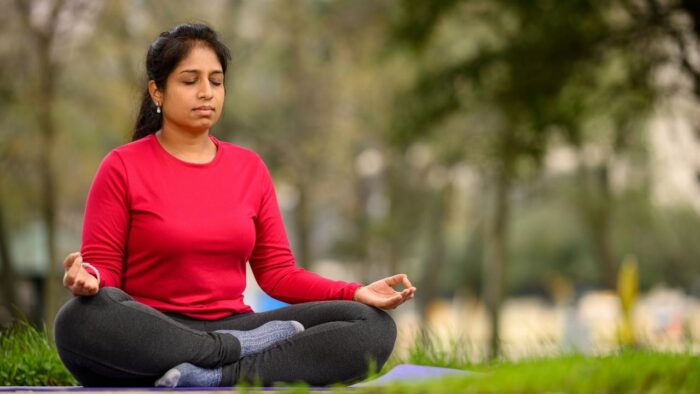Every time we step on our yoga mat, we come out of the practice feeling rejuvenated, relaxed, exhilarated and at times, we can even feel a little melancholic because yoga has a way of bringing our truth to the surface (both good and bad). The healing prowess of yoga is a fact and in addition to keeping us healthy, it can also be an effective tool to avoid and deal with even a serious illness like cancer. Smitha Mallaiah, M. Sc, C-IAYT, is a Senior Mind-Body Intervention Specialist at The University of Texas MD Anderson Cancer Center, and she uses yoga programmes to address the needs and symptom burden of individual patients going through cancer. “Yoga can be applied throughout the cancer experience from diagnosis, treatment, post-treatment, and survivorship alongside end-of-life care. The application of various practices of yoga can influence each of these systems (physical function, circadian rhythm, stress response, immune function, and others) and reduce these symptoms among cancer patients and survivors,” says Smitha, in conversation with Indica Yoga…
Sophia: Tell us about the work you do at the M D Anderson Cancer Centre?
Smitha: I work as a Senior Mind-Body Intervention specialist at The University of Texas MD Anderson Cancer Center — it’s the largest cancer center in Houston, Texas (United States). I started my work here in a research capacity, designing and teaching yoga programmes for patients with cancer. I have worked with cancer populations like breast, lung, brain, cervical, head, and neck cancers, among others.
I also run an inpatient and outpatient yoga therapy clinic, one of its first kind in the country. Here, yoga therapy is applied to address the needs and symptom burden of individual patients going through cancer using yoga therapy.
Sophia: How can Yoga be applied to cancer patients, and how does it ease their illness?
Smitha: Cancer and its treatments (chemotherapy, radiation therapy, surgery, etc.) directly and harmfully affect different systems in the body like the physical function, the circadian rhythm, stress response, immune function, and others. The side effects of cancer treatment lead to an increased physical and psychological burden, leading to symptoms like pain, fatigue, sleep disturbances, nausea, anxiety, depression, etc. This significantly impairs the quality of life for cancer patients during cancer treatment and long after survivorship.
Many think physical activity, including yoga, is needless during cancer treatment, but research shows that yoga is, in fact, more beneficial to negating the side effects of cancer care. Yoga is a holistic science, a way of life addressing the whole person and not just a disease or symptom. Yoga can be applied throughout the cancer experience from diagnosis, treatment, post-treatment, and survivorship alongside end-of-life care. The application of various practices of Yoga can influence each of these systems (physical function, circadian rhythm, stress response, immune function, and others) and reduce these symptoms among cancer patients and survivors.
Sophia: Can yoga help prevent cancer?
Smitha: A stressful, sedentary lifestyle, wrong dietary habits, smoking, and alcohol combined with environmental toxins are the major risk factors for cancer.
Yes, when we understand yoga as a way of life and not just a physical practice, yoga can help prevent cancer. Yoga begins with yamas, which facilitates harmonious connection to the world around us through non-violence, truthfulness, non-stealing, the proper use of energy and no greediness.
Niyamas, the second limb of Ashtanga yoga, helps one to connect to ourselves, respecting our body and mind and nurturing it (in a way that our modern world has forgotten self-care). Yoga encourages discipline at the body level through various yoga practices like asana (yoga postures), kriyas (cleansing techniques), pranayama (breath work), ahara (diet), and others. Yoga encourages discipline at the mind level through meditation (dharana and dhyana) and, above all, abhyasa vairagya (practice and detachment), which reminds us of the transient nature of life and shields us from longing for material things.
Sophia: Can you share some cases where you experienced first-hand how yoga helped someone suffering from cancer?
Smitha: Case 1: Mrs. JD
She is a 67-year-old female with breast cancer, post-chemo surgery, and undergoing radiation treatment. She is overweight but does not have any other diseases/comorbidities. She comes to the yoga therapy clinic complaining of pain, fatigue, depression and limited range of motion on her left arm (side of surgery).
After assessing the patient's case history and her cancer symptoms, the yoga therapist developed a personalised yoga plan for the patient. The treatment plan included yoga practices like sukshma vyama(gentle stretching), asana (yoga poses), pranayama(breath work), and dhyana (meditation) to be practised over 5-6 weeks of radiation for 12-15 sessions. She also does pranayama twice a day for 10 mins and other yoga practices, which she feels help with her fatigue. The patient's range of motion improved significantly with regular practice, and her pain score went from 8 to 3. With the reduced pain and improved range of motion, her depression has reduced, and she is motivated to take charge of her health.
Sophia: How did your journey to Yoga begin?
Smitha: When I was a young girl, my father practised yoga at home every day. I would see him turn and twist his body into different yoga postures, do his kriyas and practice silence. I never thought I would take up yoga as a profession when I grew up. Right after my schooling, I attended a month-long yoga programme from S-VYASA, after which I never looked back. Yoga provides a systematic journey into self-discovery, which to many is solace. I have witnessed desperate people find peace and health and well-being through Yoga.
Sophia: Most yoga teachers prefer to start their schools or shalas, but you choose to direct your yoga knowledge to therapy and work at a hospital. What inspired you to make this choice?
Smitha: Yoga therapy is a small part of the larger yoga umbrella. My Gurus, Dr. H R Nagendra, Ph.D., and Dr. R Nagaratha, MD, inspired me to do the work I am doing. I studied Yoga at Swami Vivekananda Yoga Anusandhana Samsthana - SVYASA, a yoga university that is the first yoga university to bring yoga as a system of education systematically. This is also the first university to have a full-fledged research lab looking into the research of yoga practices at all different levels. I was also part of many research studies using yoga as an intervention to treat other health issues. Seeing the first-hand benefits of yoga for my patients/clients motivates me to continue doing my work.
Sophia: How do allopathic doctors in the West react to Yoga, which is a subjective science?
Smitha: Many allopathic doctors are worried about complementary and alternative therapies in general; others are curious or unsure because it is subjective.
In the United States, the use of Yoga increased from 9.5% to 14.3%, and meditation rose from 4.1% to 14.2% between 2012 and 2017. Today, more than ever before, we have more research and evidence informing the role of yoga in several mechanisms and quality of life studies. Many doctors are convinced when they see the proof of integrating these therapies into conventional care, especially when they hear it from their patients. Many medical doctors are also part of the research that we conduct.
Sophia: What advice would you give to practitioners or teachers who want to focus on yoga as therapy?
Smitha: Standards: Yoga is a holistic system of medicine that can address various health needs of the patient and not just the disease. Because patient care is involved, we should also set standards for practising yoga as therapy. When in the field, you compare yourselves with other complementary and alternative medicine (CAM) modalities like acupuncture, music therapy, massage therapy, and others. All these fields have standards for education before they can treat a patient. So, yoga therapists should be competent too.
Keep Yoga in Yoga therapy: The field of yoga therapy is neither better nor different than yoga itself. Study yoga, practice yoga, and teach yoga, let yoga be your sadhana.
Healing: There is a more profound satisfaction in facilitating the healing process for people in suffering. If you like working with people, there are a lot of people who will benefit from yoga therapy and working with you.
Sophia: Can you name a few spiritual masters who have inspired your work and why?
Smitha: That is a difficult question; when you are born and raised in India, your inspiration for the spiritual path is boundless. My constant inspiration has been Swami Vivekananda, Ramakrishna Paramahamsa, and Sharada ma, along with my Gurus. They have been inspirational to humankind for character building, unconditional love, and leading a life of selflessness of service to others.
Sophia: What are you reading right now, and can you recommend your favourite books on yoga and spirituality?
Smitha: Patanjali yoga sutras and Bhagavad-Gita are my all-time favourites. You can never complete reading and absorbing these two texts or what they have to offer to any problematic situation in life.
To find out more about how Smitha uses yoga to help cancer patients, join her Yoginsights session, Role of Yoga in Cancer Care, on Friday, 5th August between 6pm - 7 pm IST.





